Wednesday☕️

Economics & Markets:
- Yesterday’s U.S. stock market:

- Today’s commodity market:

- Today’s crypto market:
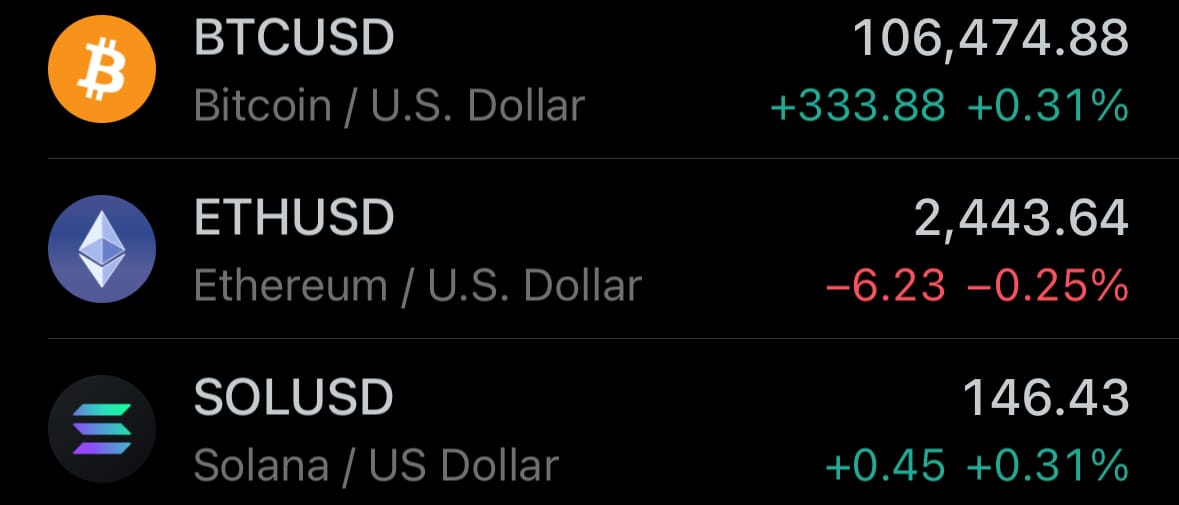
Environment & Weather:
- Yesterday, June 24, 2025, Changchi Plaza, the largest shopping mall in Rongjiang County, Guizhou, China, experienced severe flooding due to heavy rainfall. The floodwaters inundated the mall’s ground floor, underground garages, and basement, causing significant damage to merchandise and vehicles. This incident occurred amid widespread flooding in Southwest China, where continuous rainfall since June 18 led to rivers, such as the Duliu River, overflowing with a reported peak flow of 11,400 cubic meters per second, exceeding normal levels by 11 meters. The flooding affected towns and infrastructure across Guizhou’s mountainous region, prompting the evacuation of over 80,000 people, including 48,900 from Rongjiang County.

- By noon on June 24, Rongjiang County’s flood alert was raised to its highest level, with water levels projected to reach 255 meters, 3.5 meters above the safety threshold. As of June 25, 2025, at 03:22 AM EDT, the region continues to face flooding, with additional rainfall expected. Rescue operations, including efforts by the Qiandongnan Fire and Rescue Brigade, evacuated or rescued 84 people by the morning of June 24. Infrastructure, including roads and a local football field submerged under three meters of water, remains heavily impacted. The full extent of the damage to Changchi Plaza is still under assessment, but the event highlights the significant challenges posed by extreme weather in the region.
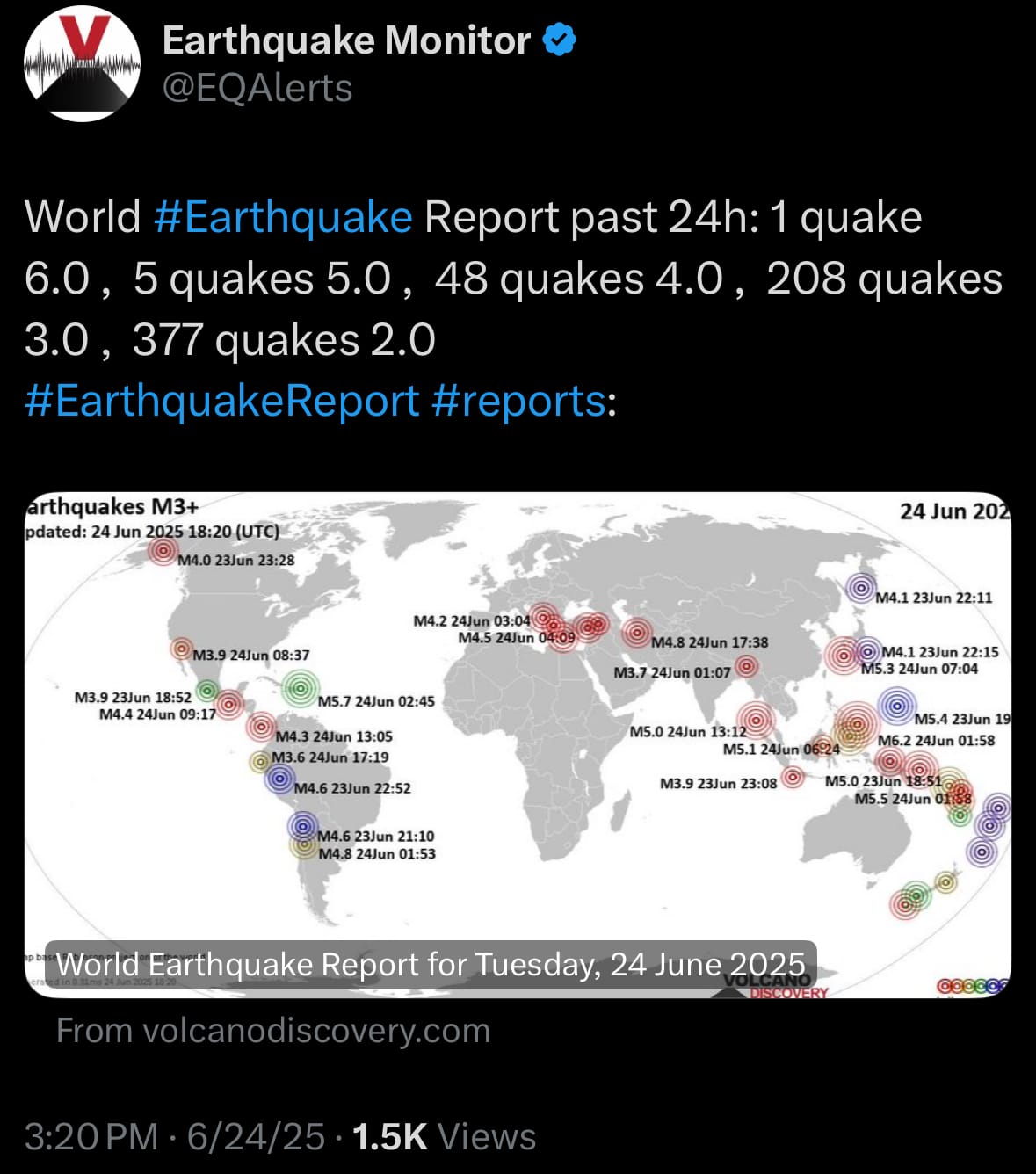
Space:
- Today, June 25, 2025, SpaceX launched Axiom Mission 4 (Ax-4), Axiom Space’s fourth private crew rotation to the International Space Station (ISS), from Launch Pad 39A at NASA’s Kennedy Space Center in Florida. The mission utilized a SpaceX Falcon 9 rocket and a Crew Dragon spacecraft to carry a crew of four: commander Peggy Whitson (a former NASA astronaut), Shubhanshu Shukla (India), Sławosz Uznański (Poland), and Tibor Kapu (Hungary). This marks the first crewed ISS mission for India and Poland. The crew is set to dock with the ISS’s Harmony module on June 26, 2025, for a 14-day mission focused on scientific research and technology demonstrations to advance Axiom’s plans for a commercial space station.
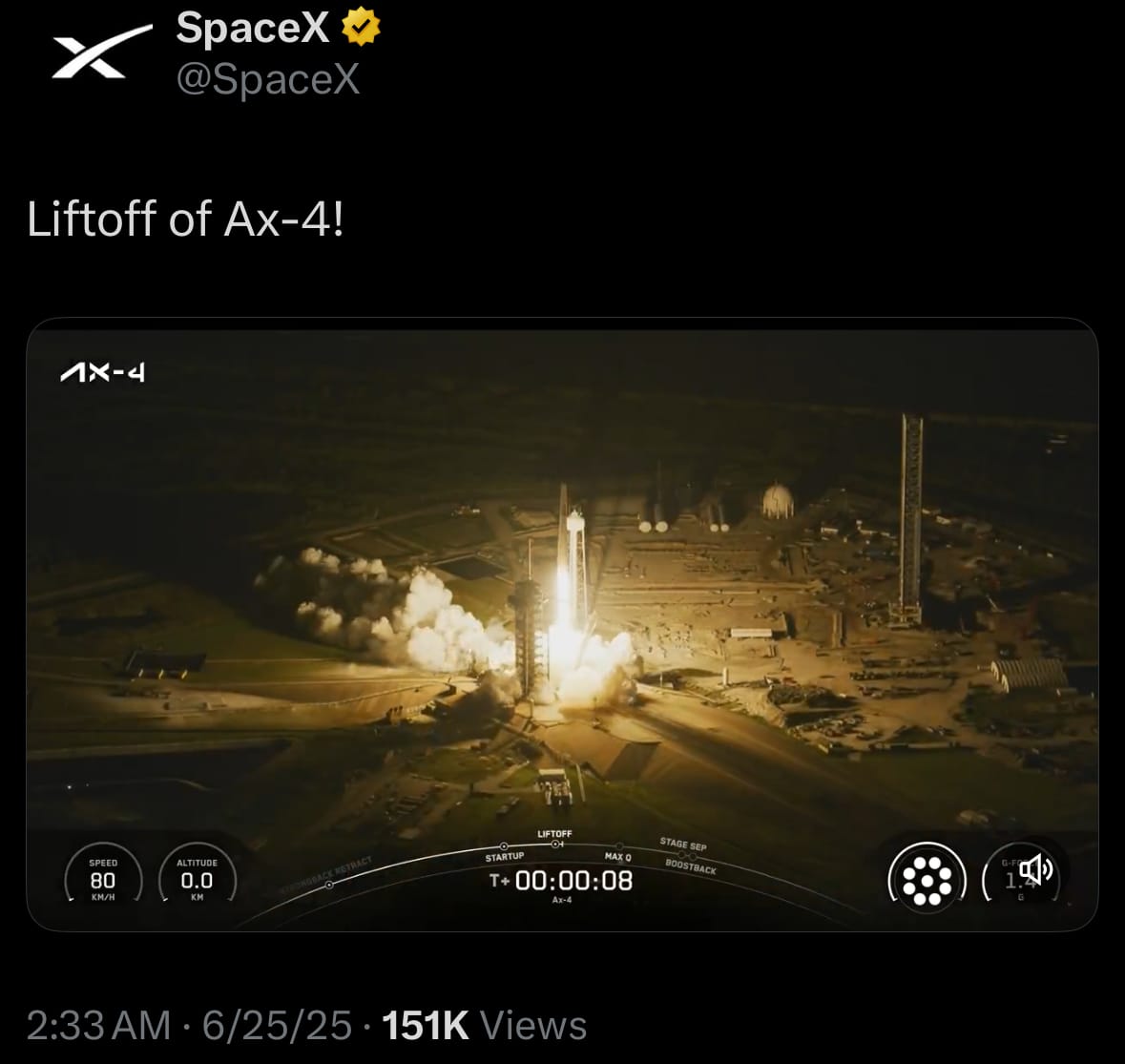
- The Ax-4 mission carries a payload of over 60 experiments from 31 countries, covering health, materials science, and technology development. Launched at 2:31 a.m. EDT, the mission overcame prior delays due to a liquid oxygen leak and weather challenges. The crew will join the ISS’s Expedition 73 team to conduct studies aimed at improving space health monitoring and developing future space habitats. While mission costs are not publicly detailed (previous Axiom missions estimated at $55–60 million per seat) and the mission is not open source, Ax-4 supports international collaboration and commercial spaceflight.
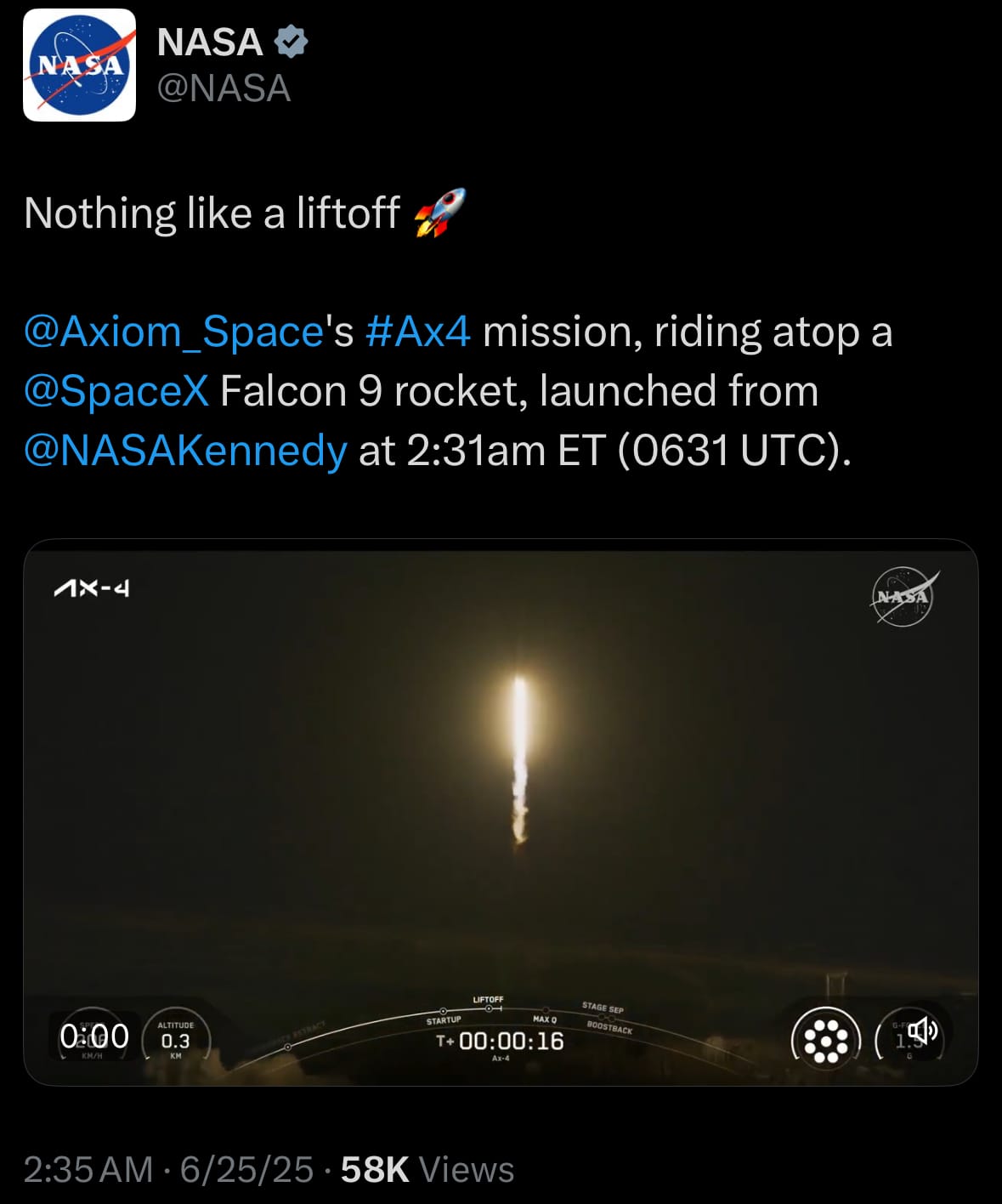
Science & Technology:
- Yesterday, June 24, 2025, Google DeepMind announced Gemini Robotics On-Device, a vision-language-action (VLA) AI model designed to run locally on robotic devices without internet connectivity. This advancement builds on the earlier Gemini Robotics framework, aiming to enhance robot autonomy and efficiency in environments where cloud dependency is impractical. The model's ability to operate offline addresses challenges like latency and connectivity, positioning it as a significant step forward in robotics AI for both industrial and domestic applications.
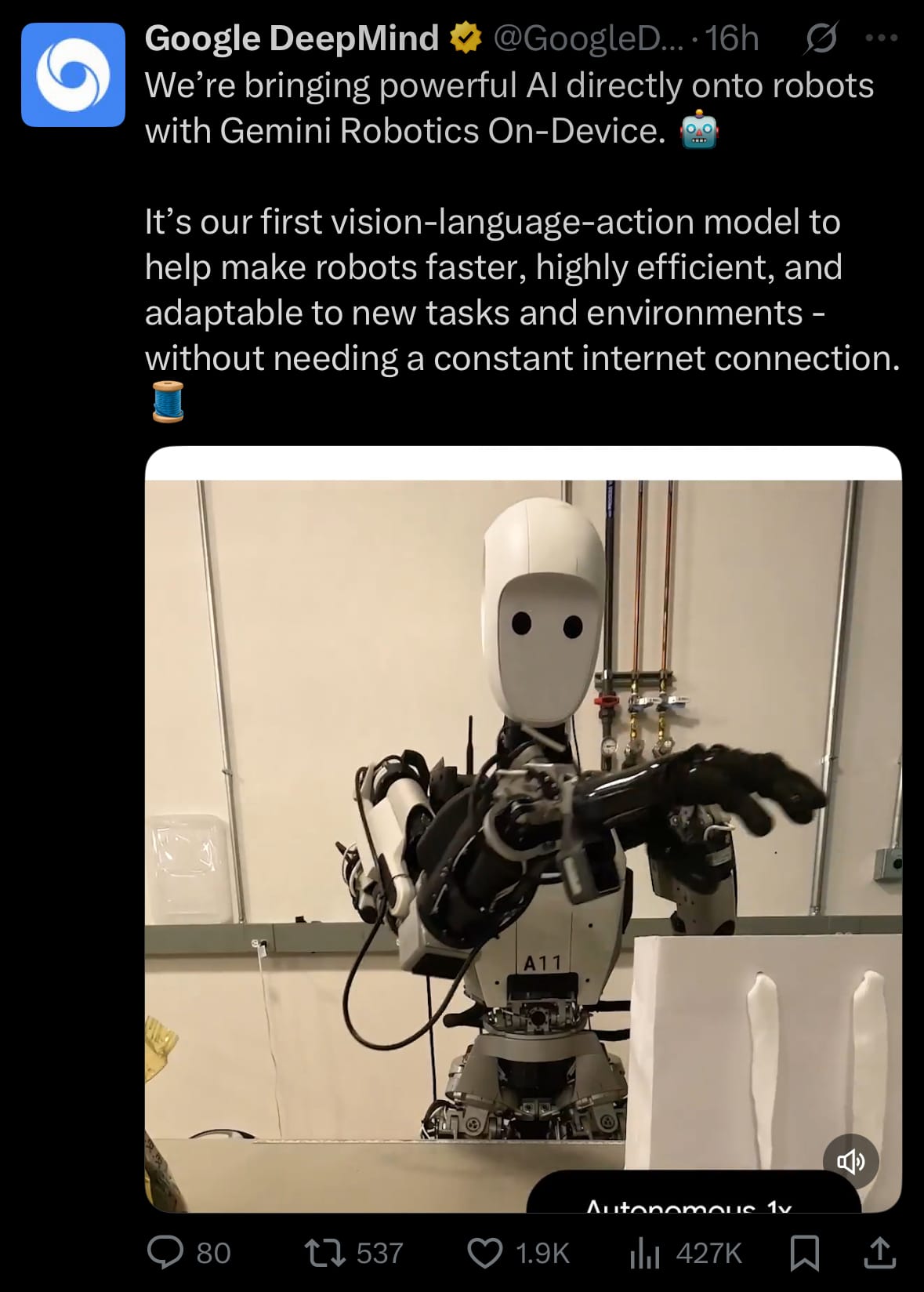
- The capabilities of Gemini Robotics On-Device include general-purpose dexterity, enabling robots to perform complex tasks such as folding clothes, unzipping bags, and pouring salad dressing with minimal training (50–100 demonstrations). It supports natural language instructions, adapts to new tasks and environments, and delivers low-latency inference, making it suitable for real-time operations. Compatible with platforms like ALOHA, Franka FR3, and Apollo humanoid robots, it outperforms other on-device models in benchmarks, though it is currently limited to trusted testers via the Gemini Robotics SDK. Safety measures and a focus on privacy through local processing underscore Google’s commitment to responsible deployment, with potential to transform industries like manufacturing and healthcare pending broader testing.
Statistic:
- Largest public telecommunication companies by market capitalization:
- 🇺🇸 T-Mobile US: $260.94B
- 🇨🇳 China Mobile: $243.35B
- 🇺🇸 AT&T: $203.63B
- 🇩🇪 Deutsche Telekom: $180.50B
- 🇺🇸 Verizon: $179.73B
- 🇮🇳 Bharti Airtel: $136.93B
- 🇺🇸 Comcast: $131.46B
- 🇺🇸 American Tower: $104.82B
- 🇨🇳 China Telecom: $95.17B
- 🇯🇵 SoftBank: $91.24B
- 🇯🇵 NTT (Nippon Telegraph & Telephone): $85.64B
- 🇯🇵 KDDI: $65.72B
- 🇸🇦 Saudi Telecom Company: $56.77B
- 🇺🇸 Charter Communications: $55.73B
- 🇲🇽 America Movil: $52.14B
- 🇸🇬 Singtel: $48.65B
- 🇺🇸 Crown Castle: $44.93B
- 🇦🇪 Emirates Telecom (Etisalat Group): $40.54B
- 🇫🇷 Orange: $39.38B
- 🇨🇭 Swisscom: $36.58B
- 🇭🇰 China Unicom: $36.17B
- 🇹🇼 Chunghwa Telecom: $35.80B
- 🇦🇺 Telstra: $35.62B
- 🇪🇸 Telefónica: $29.94B
- 🇪🇸 Cellnex Telecom: $26.56B
History:
- The history of global telecommunications networks began in the early 19th century with the invention of the telegraph, which enabled long-distance communication through Morse code over wired lines. Samuel Morse’s 1844 demonstration of the telegraph in the U.S. marked a pivotal breakthrough, followed by the laying of the first transatlantic telegraph cable in 1858, connecting North America and Europe. By the late 1800s, Alexander Graham Bell’s telephone (1876) revolutionized voice communication, leading to the rapid expansion of telephone networks. The early 20th century saw the rise of major players like AT&T in the U.S. and the establishment of national postal, telegraph, and telephone (PTT) organizations in Europe and beyond. Radio communication emerged in the 1890s, with Guglielmo Marconi’s transatlantic radio transmission in 1901, enabling wireless telegraphy. By the mid-20th century, microwave relay systems and coaxial cables improved long-distance telephony, while the 1956 transatlantic telephone cable (TAT-1) enhanced global voice connectivity. The Cold War era spurred satellite communications, with the launch of Telstar in 1962 enabling the first transatlantic television broadcasts.
- The late 20th and early 21st centuries marked the digital revolution in telecommunications, driven by the development of fiber-optic cables, mobile networks, and the internet. The 1988 deployment of the first transatlantic fiber-optic cable (TAT-8) vastly increased data capacity, supporting the growing internet, which began as ARPANET in 1969 and expanded globally with the World Wide Web in 1989. Mobile communications advanced with the launch of 1G analog cellular networks in the 1980s, followed by 2G digital networks in the 1990s, led by companies like Nokia and Ericsson. The 2000s brought 3G and 4G, enabling mobile broadband, with major players like Apple and Samsung shaping the smartphone era. The 2010s saw the rise of 5G, with Huawei and Qualcomm leading innovations for ultra-fast, low-latency networks. Submarine cables now carry over 99% of international data, while low-earth-orbit satellite systems like Starlink aim to provide global broadband. Key breakthroughs—fiber optics, TCP/IP protocols, and mobile standards—have transformed telecommunications into a backbone of global connectivity, with ongoing advancements in AI and quantum communication shaping the future.
Image of the day:

Thanks for reading!
Earth is complicated, we make it simple.
Click image to view the Earth Intelligence System:



Support/Suggestions Email:
earthintelligence@earthintel.news




